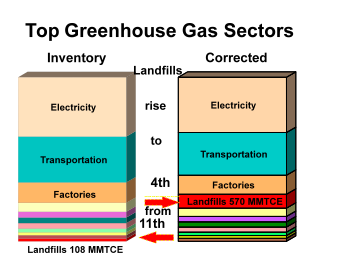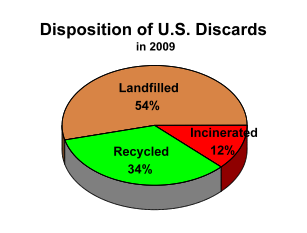Why We Need To Pay More Attention To The Role Of Landfills In Global Warming
 Landfills, the current destination for a majority of our trash, are a major source of methane.
Landfills, the current destination for a majority of our trash, are a major source of methane.Recent accounts that have filtered back to Climate Progress from Rio+20 suggested satisfaction with a World Bank Report concluding “Integrated waste management” (which purports to prioritize recycling over landfilling), is being implemented in the developed countries.
We have been left with the impression it is just the undeveloped world landfills still present a problem.
But, stripped of its window dressing, “integrated” is just bureaucratic speak for a blank check to the U.S. disposal industry. Sagaciously, the national firms duly consider all options, and then,\ select the one that is most profitable to them (other than in green cities that insist upon better than that). Morgan Stanley Dean Witter reports that the industry’s view is: “recycling has long been the enemy of the solid waste industry, stealing volumes otherwise headed for landfills … their most promising assets.”
Fortunately, one organization did not ignore the waste sector. In 2009, the Sierra Club undertook a year-long due diligence. Peeling back the onion layers, its technical experts found that industry’s claims – that their operators captured most of the methane generated in landfills, and that landfill-gas-to-energy (LFGTE) miraculously converted lemons into lemonade – were as bogus as the ethanol deceit. In fact, landfills were responsible for almost five times more GHG emissions than understood. Attempts to recover energy from inherently low Btu and dirty gas only made bad things worse.
Methane is so potent a greenhouse gas, even small leaks from major generators of methane are a huge concern – depending how much escapes.
Major volume of methane generated
Over the 100 years or so that landfills generate gas, methane equivalent to roughly 472 million tons of carbon dioxide will be generated from just one year of municipal trash in the U.S. That is a third more than from heating and cooling all of the homes in the country.
Most landfill gas escapes
 The Intergovernmental Panel on Climate Change (IPCC) reviewed the waste sector in its 2007 Fourth Assessment Report. In reference to the industry’s claims, the Panel acknowledged the possibility that the best landfills might achieve very high capture rates when there is functioning gas collection and the site is sealed. But, of course, the best of the best has little to do with actual long-term impacts.
The Intergovernmental Panel on Climate Change (IPCC) reviewed the waste sector in its 2007 Fourth Assessment Report. In reference to the industry’s claims, the Panel acknowledged the possibility that the best landfills might achieve very high capture rates when there is functioning gas collection and the site is sealed. But, of course, the best of the best has little to do with actual long-term impacts.The IPCC pointedly noted that in contrast to the best operations, “some sites have less efficient or only partial gas extraction systems and there are fugitive emissions from landfilled waste prior to and after the implementation of active gas generation.” More importantly, it found most of the “fugitive emissions from landfilled waste [occurs] prior to and after the implementation of active gas extraction; thus estimates of ‘lifetime’ recovery efficiencies may be as low as 20%” – that is, most escapes.
Energy recovery makes a bad situation worse
Landfill-gas-to-energy (LFGTE) is said to be beneficial because that energy produced at the site can offset the need to generate power on the utility grid, along with emissions of carbon dioxide. If correct, LFGTE sites would provide a positive net benefit to climate efforts.
But, that puts forward the wrong comparison. Because methane is such a high octane warming gas, and because some methane escapes (even in the landfill industry’s goldilocks tale of gas collection efficiency), diverting the organic discards – which in landfills, and only in landfills, generate significant volumes of methane – is, EPA says, is always preferred.
For the waste that is already buried in landfills, diversion is no longer practical. However, as the Sierra Club’s year long investigation found, landfills operated to minimize fugitive gas have too few Btus to productively generate power. The operational changes needed to produce gas with enough energy value are significant: companies must augment moisture levels, shift gas production from the distant future to the present, and enhance the proportion of the gas that is methane. More gas is produced, more of which is methane, more of which escapes, all of which overwhelms the LFGTE’s benefits in CO2 reductions. A real live dispute at a New Hampshire landfill illustrates the irreconcilable conflict between gas collection and power production.
Landfills are the fourth largest source of GHGs
There are two major errors in how landfills’ greenhouse gas emissions have historically been accounted for: first, in outdated calculations of methane’s global warming potential (21× CO2 instead of 33×), and, second, overstated guesstimates of landfill gas collection efficiency.
Fixing them has significant implications for correctly assessing landfills’ responsibility for greenhouse gases. If the wrong numbers are used, as done in traditional GHG inventories, landfills only appear to be responsible for 1.6% of total man-made emissions. However, when these mistakes are fixed, landfills climate almost 5× conventional inventories, representing 7.5% of climate changing gases.
This correction pushes landfills from the 11th largest contributor to climate change to the 4th, right after the very biggest ones: electricity generation, transportation and factories.
Contrary to the climate commandeers’ claims, landfills are, it turns out, among the largest sources of climate changing emissions, and even more so in the next critical 20 years when methane’s warming potential is more than 100× CO2’s.
Landfills are a major source of emissions. And we can’t allow for “climatewashing” that covers up that impact.
You can return to the main Market News page, or press the Back button on your browser.

